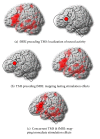Adaptive Plasticity in the Healthy Language Network: Implications for Language Recovery after Stroke
- PMID: 27830094
- PMCID: PMC5088318
- DOI: 10.1155/2016/9674790
Adaptive Plasticity in the Healthy Language Network: Implications for Language Recovery after Stroke
Abstract
Across the last three decades, the application of noninvasive brain stimulation (NIBS) has substantially increased the current knowledge of the brain's potential to undergo rapid short-term reorganization on the systems level. A large number of studies applied transcranial magnetic stimulation (TMS) and transcranial direct current stimulation (tDCS) in the healthy brain to probe the functional relevance and interaction of specific areas for different cognitive processes. NIBS is also increasingly being used to induce adaptive plasticity in motor and cognitive networks and shape cognitive functions. Recently, NIBS has been combined with electrophysiological techniques to modulate neural oscillations of specific cortical networks. In this review, we will discuss recent advances in the use of NIBS to modulate neural activity and effective connectivity in the healthy language network, with a special focus on the combination of NIBS and neuroimaging or electrophysiological approaches. Moreover, we outline how these results can be transferred to the lesioned brain to unravel the dynamics of reorganization processes in poststroke aphasia. We conclude with a critical discussion on the potential of NIBS to facilitate language recovery after stroke and propose a phase-specific model for the application of NIBS in language rehabilitation.
Figures



Similar articles
-
Neuroimaging of stroke recovery from aphasia - Insights into plasticity of the human language network.Neuroimage. 2019 Apr 15;190:14-31. doi: 10.1016/j.neuroimage.2017.11.056. Epub 2017 Nov 23. Neuroimage. 2019. PMID: 29175498 Review.
-
Probing rapid network reorganization of motor and language functions via neuromodulation and neuroimaging.Neuroimage. 2021 Jan 1;224:117449. doi: 10.1016/j.neuroimage.2020.117449. Epub 2020 Oct 12. Neuroimage. 2021. PMID: 33059054 Review.
-
The neurophysiology of language: Insights from non-invasive brain stimulation in the healthy human brain.Brain Lang. 2015 Sep;148:81-94. doi: 10.1016/j.bandl.2014.10.007. Epub 2014 Nov 15. Brain Lang. 2015. PMID: 25468733 Review.
-
Novel methods to study aphasia recovery after stroke.Front Neurol Neurosci. 2013;32:101-11. doi: 10.1159/000346431. Epub 2013 Jul 8. Front Neurol Neurosci. 2013. PMID: 23859969 Review.
-
Non-invasive brain stimulation (NIBS) and motor recovery after stroke.Ann Phys Rehabil Med. 2014 Nov;57(8):530-542. doi: 10.1016/j.rehab.2014.08.003. Epub 2014 Aug 23. Ann Phys Rehabil Med. 2014. PMID: 25193774 Review.
Cited by
-
Toward individualized medicine in stroke-The TiMeS project: Protocol of longitudinal, multi-modal, multi-domain study in stroke.Front Neurol. 2022 Sep 26;13:939640. doi: 10.3389/fneur.2022.939640. eCollection 2022. Front Neurol. 2022. PMID: 36226086 Free PMC article.
-
Identification of Phonology-Related Genes and Functional Characterization of Broca's and Wernicke's Regions in Language and Learning Disorders.Front Neurosci. 2021 Sep 3;15:680762. doi: 10.3389/fnins.2021.680762. eCollection 2021. Front Neurosci. 2021. PMID: 34539327 Free PMC article.
-
DUAL-tDCS Treatment over the Temporo-Parietal Cortex Enhances Writing Skills: First Evidence from Chronic Post-Stroke Aphasia.Life (Basel). 2021 Apr 14;11(4):343. doi: 10.3390/life11040343. Life (Basel). 2021. PMID: 33919714 Free PMC article.
-
From Broca and Wernicke to the Neuromodulation Era: Insights of Brain Language Networks for Neurorehabilitation.Behav Neurol. 2019 Jul 22;2019:9894571. doi: 10.1155/2019/9894571. eCollection 2019. Behav Neurol. 2019. PMID: 31428210 Free PMC article. Review.
-
Perilesional and homotopic area activation during proverb comprehension after stroke.Brain Behav. 2019 Jan;9(1):e01202. doi: 10.1002/brb3.1202. Epub 2018 Dec 26. Brain Behav. 2019. PMID: 30588768 Free PMC article.
References
-
- Broca P. Perte de la parole. Bulletins da la Societé Anthropologique de Paris. 1861;2:235–238.
-
- Wernicke C. Der aphasische Symptomencomplex. Breslau, Poland: Cohn and Weigert; 1874.
Publication types
MeSH terms
LinkOut - more resources
Full Text Sources
Other Literature Sources
Medical

